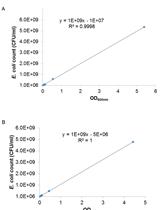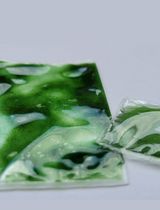- EN - English
- CN - 中文
Determination of the Predatory Capability of Bdellovibrio bacteriovorus HD100
测定噬菌蛭弧菌HD100的掠食能力
发布: 2017年03月20日第7卷第6期 DOI: 10.21769/BioProtoc.2177 浏览次数: 11518
评审: Dennis NürnbergAmit DeyAnonymous reviewer(s)
Abstract
Bdellovibrio bacteriovorus HD100 is an obligate predator that preys upon a wide variety of Gram negative bacteria. The biphasic growth cycle of Bdellovibrio includes a free-swimming attack phase and an intraperiplasmic growth phase, where the predator replicates its DNA and grows using the prey as a source of nutrients, finally dividing into individual cells (Sockett, 2009). Due to its obligatory predatory lifestyle, manipulation of Bdellovibrio requires two-member culturing techniques using selected prey microorganisms (Lambert et al., 2003). In this protocol, we describe a detailed workflow to grow and quantify B. bacteriovorus HD100 and its predatory ability, to easily carry out these laborious and time-consuming techniques.
Keywords: Bdellovibrio bacteriovorus (噬菌蛭弧菌)Background
In the last years, Bdellovibrio has attracted the interest of the scientific community and several applications have been developed, such as evolution studies (Davidov and Jurkevitch, 2009), identification of new biocatalysts (Martínez et al., 2012), therapeutic applications (Atterbury et al., 2011), or biotechnological applications using Bdellovibrio as a lytic agent for the recovery of value added intracellular bioproducts (Martínez et al., 2016). Due to the growing interest in Bdellovibrio, different indirect methods to quantify this predatory bacterium have been developed (Mahmoud et al., 2007; Lambert and Sockett, 2008; Van Essche et al., 2009). However, direct quantification of Bdellovibrio via double-layer method is still necessary to thoroughly characterize Bdellovibrio predatory capability. Here, we describe a well-established, reliable, and broadly used method that allows Bdellovibrio cell number quantification in predatory co-cultures.
Materials and Reagents
- 0.45 µm sterilization filter (Sartorius, catalog number: 16555-K )
- 0.22 µm sterilization filter (Sartorius, catalog number: 16532-K )
- 10-ml glass test tubes (Fisher Scientific, catalog number: 15175134 )
- Glass microscope slides (76 x 26 mm) (Thermo Fisher Scientific, Thermo ScientificTM, catalog number: 10143562BEF ) (see Note 1)
- Glass microscope coverslips (22 x 22 mm) (Thermo Fisher Scientific, Thermo ScientificTM, catalog number: 3306 )
- 10 ml syringe (BD, catalog number: 307736 )
- Bdellovibrio bacteriovorus HD100 (ATCC, catalog number: 15356 ) (Stolp and Starr, 1963)
- Pseudomonas putida KT2440 (ATCC, catalog number: 47054 ) (Nelson et al., 2002)
- Glycerol (EMD Millipore, catalog number: 104094 )
- Bacto tryptone (BD, BactoTM, catalog number: 211705 )
- Yeast extract (Conda, catalog number: 1702 )
- Sodium chlorice (NaCl) (EMD Millipore, catalog number: 106404 )
- Sodium hydroxide (NaOH) pellets for analysis (EMD Millipore, catalog number: 106498 )
- Agar (BD, BactoTM, catalog number: 214010 )
- Nutrient broth (NB) (BD, DifcoTM, catalog number: 234000 )
- Calcium chloride dihydrate (CaCl2·2H2O) (EMD Millipore, catalog number: 102382 )
- Magnesium chloride hexahydrate (MgCl2·6H2O) (EMD Millipore, catalog number: 105833 )
- HEPES buffer (Sigma-Aldrich, catalog number: H3375 )
- Lysogeny broth (LB) medium (1 L, pH 7.5) (see Recipes)
- LB, 1.5% (w/v) agar (see Recipes)
- NB medium (1 L) (see Recipes)
- CaCl2 and MgCl2 salts (see Recipes)
- Diluted nutrient broth (DNB) medium (1 L, pH 7.4) (see Recipes)
- DNB, 0.7% (w/v) agar (see Recipes)
- DNB, 1.5% (w/v) agar (see Recipes)
- HEPES buffer (see Recipes)
Equipment
- Centrifuge (Eppendorf, model: 5810 R )
- 100 ml flasks
- 30 °C chamber (JP Select, catalog number: 001257 )
- 30 °C shaking incubator (250 rpm) (Eppendorf, New BrunswickTM, model: Innova® 44 )
- Water bath (JP Select, catalog number: 6000138 )
- Phase contrast microscopy (Nikon Instruments, model: OPTIFHOT-2 ) (Note 1)
- Spectrophotometer (Shimadzu, model: UV-260 )
- Leica DFC345 FX camera (Leica Microsystems, model: DFC345 FX )
- Autoclave
Procedure
文章信息
版权信息
© 2017 The Authors; exclusive licensee Bio-protocol LLC.
如何引用
Herencias, C., Prieto, M. A. and Martínez, V. (2017). Determination of the Predatory Capability of Bdellovibrio bacteriovorus HD100. Bio-protocol 7(6): e2177. DOI: 10.21769/BioProtoc.2177.
分类
微生物学 > 微生物细胞生物学 > 细胞活力
细胞生物学 > 细胞活力 > 捕食
您对这篇实验方法有问题吗?
在此处发布您的问题,我们将邀请本文作者来回答。同时,我们会将您的问题发布到Bio-protocol Exchange,以便寻求社区成员的帮助。
Share
Bluesky
X
Copy link













